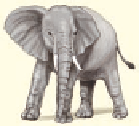Environmental Engineering Reference
In-Depth Information
r-Selected Species
K-Selected Species
Dandelion
Elephant
Saguaro
Cockroach
Many small offspring
Fewer, larger offspring
Little or no parental care and protection of offspring
High parental care and protection of offspring
Early reproductive age
Later reproductive age
Most offspring die before reaching reproductive age
Most offspring survive to reproductive age
Small adults
Larger adults
Adapted to unstable climate and environmental conditions
Adapted to stable climate and environmental conditions
High population growth rate (r)
Lower population growth rate (r)
Population size fluctuates wildly above and below carrying
capacity (K)
Population size fairly stable and usually close to carrying
capacity (K)
Generalist niche
Specialist niche
Low ability to compete
High ability to compete
Early successional species
Late successional species
Figure 6-15
Natural capital:
generalized characteristics of
r-selected
(opportunist) species and
K-
selected
(competitor) species. Many species have characteristics between these two extremes.
tend to reproduce late in life and have a small number
of offspring with fairly long life spans. Typically the
offspring of such species develop inside their mothers
(where they are safe), are born fairly large, mature
slowly, and are cared for and protected by one or both
parents until they reach reproductive age. This repro-
ductive pattern results in a few big and strong individ-
uals that can compete for resources and reproduce a
few young to begin the cycle again.
Such species are called K-selected species because
they tend to do well in competitive conditions when
their population size is near the carrying capacity (
K
)
of their environment. Their populations typically fol-
low a logistic growth curve (Figure 6-11).
Most large mammals (such as elephants, whales,
and humans), birds of prey, and large and long-lived
plants (such as the saguaro cactus, and most tropical
rain forest trees) are K-selected species. Many K-
selected species—especially those with long genera-
tion times and low reproductive rates like elephants,
rhinoceroses, and sharks—are prone to extinction.
Most organisms have reproductive patterns be-
tween the extremes of r-selected species and K-
selected species, or they change from one extreme to
the other under certain environmental conditions. In
agriculture we raise both r-selected species (crops) and
K-selected species (livestock).
The reproductive pattern of a species may give it a
temporary advantage, but
the availability of a suitable
habitat for individuals of a population in a particular area
determines its ultimate population size.
No matter how
fast a species can reproduce, there can be no more
dandelions than there is dandelion habitat and no
more zebras than there is zebra habitat in a particular
area.
Explore survivorship curves, showing how certain
species differ in their typical lifespans, at Environmental
ScienceNow.
6-6 HUMAN IMPACTS ON
ECOSYSTEMS: LEARNING FROM
NATURE
Human Modification of Natural
Ecosystems: Our Big Footprints
We have used technology to alter nature to meet our
growing needs and wants in eight major ways that
threaten the survival of many other species and
ultimately could reduce the quality of life for our own
species.












